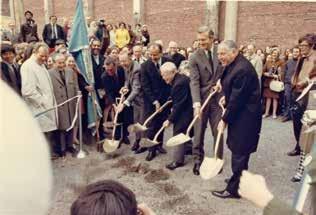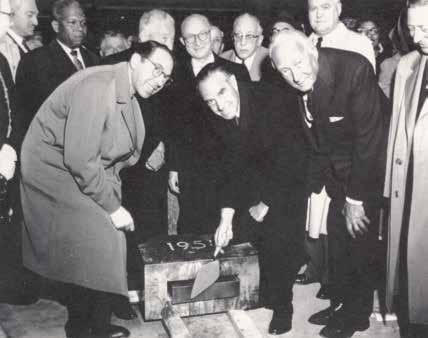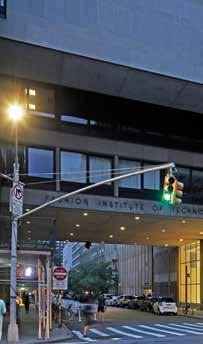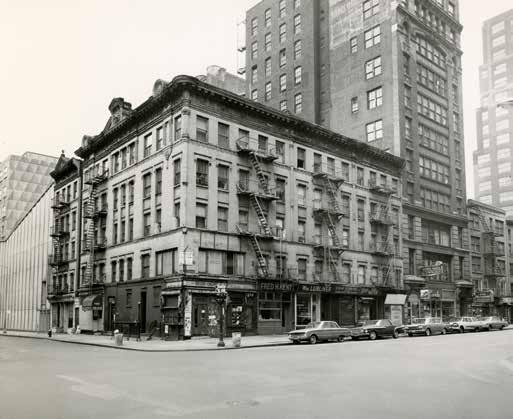
4 minute read
In the Beginning
Top row: FIT under construction in 1958; community leaders lay the cornerstone for FIT’s first building; the David Dubinsky Student Center was built in the early ’70s. Middle row: Groundbreaking for four new buildings in 1969; the northwest corner of West 27th Street and Seventh Avenue in the ’60s. Bottom row: Signing of FIT’s first union contract in 1967; the new Art and Design Gallery in the Pomerantz Center today.






THEN
NOW ➥

In theBeginning
A history of the college’s early years— and a glimpse into its future
BY JENNIFER LOCONTE AND JONATHAN VATNER

Seventy-five years after FIT’s founding, as fashion degree programs have become commonplace worldwide, it’s hard to grasp just how radical an experiment it was to create the first college devoted to the apparel industry. But in the early 1940s, when the New York State Board of Regents established educational programs and colleges to educate World War II veterans and retrain war workers for private industry, apparel—the state’s largest industry—was ignored. Max Meyer and Dr. Mortimer C. Ritter advocated for this essential education. After unsuccessfully pitching fashion programs to several existing colleges, they decided to start their own.
With financial pledges from industry leaders, they formed the Educational Foundation of the Apparel Industry to establish and fund the college. (It later became the Educational Foundation for the Fashion Industries and is now the FIT Foundation.) The foundation was granted a charter from the New York Board of Regents in 1944 to establish the Fashion Institute of Technology and Design. (“Design” was cut early on.) The New York City Board of Education provided 10 teachers, machinery, and space on the top two floors of the Central High School of Needle Trades (now the High School of Fashion Industries). The foundation provided scholarships, additional teachers, and experts from the fashion industry to participate.
In September 1944, FIT opened its doors to 100 students. Two majors were offered: Apparel, Millinery, and Textile Design prepared students for positions as workroom executives and designers, and Scientific Management students would become foremen, management engineer’s assistants, and assistant plant managers. Courses included Tailoring Techniques, Costume Design, Business Law, Marketing, Labor Relations, History, Sociology, Speech, and Painting. Tuition was free for New York City residents, and expenses for books and supplies totaled around $75 per year.
In 1948, the New York State Legislature established the State University of New York (SUNY) system, which included a program for two-year community colleges. In 1951, FIT became the second community college in the state and the first in New York City.
From the beginning, spots were in high demand, and the college outgrew its shared space almost as soon as it opened. In 1959, it moved three blocks north to its own building on West 27th Street, where it remained. The $15 million aluminum and glass structure—named the Marvin Feldman Center in 1992—accommodated 1,200 students and became the cornerstone of FIT’s current campus, which encompasses the entire block and serves nearly 9,000 students, in both full-time and continuing education programs.
The United College Employees of FIT/American Federation of Teachers Local 3457, the first public higher education union in the state, was founded in 1967, representing full-time faculty; by 1970, staff and part-time employees were included, too. FIT is still the only New York college with such an inclusive union contract, and it became the model for unions at colleges across the country.
In 1969, the Brooklyn Museum loaned its costume and textile collections to the college to launch the Design Laboratory, which in 1993 became The Museum at FIT, a world-class resource for students and designers, with its holdings of 50,000 garments and accessories dating from the 18th century to the present. Accredited by the American Alliance of Museums, it is one of a few museums in the world devoted to the art of fashion.
As the creative industries have evolved, so too has FIT. Even Meyer and Ritter, visionaries of their time, would surely be amazed to see the college on its 75th anniversary. Physically, it has expanded to nine buildings in New York City and has campuses in Italy and South Korea. Educational offerings, still an unparalleled blend of hands-on practical skills and conceptual thinking, have vastly increased to 48 undergraduate and master’s programs in diverse design and business fields.
An educational authority in the new creative economy, the college is committed to research and innovation, drawing on the insight and influence of faculty, students, alumni, and industry partners to solve global challenges. An inspiring new academic building on West 28th Street, soon to break ground, will provide flexible classroom and lab space to further this goal. And the college’s new brand, Nurturing Unconventional Minds, draws independent thinkers eager to help transform the creative industries. FIT, a pioneering institution from the beginning, is strengthened by its rich history but continues to stride boldly toward a brighter future.










